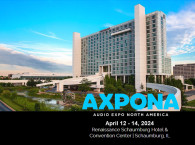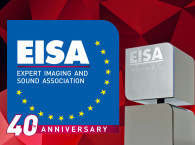Yes, it was strange to fly to Denver, CO so early in September while most of the industry was on the way to Berlin, Germany for another edition of the International Funkausstellung (IFA), the gigantic consumer electronics and appliance show, which rivals CES in visitor numbers. But the fact is, I don’t regret it in the least.
Since the 2019 edition of the Rocky Mountain International Audio Fest (RMAF) changed dates to September 6-8, and the CEDIA Expo takes place shortly after also in Denver (with the exhibition opening its doors as you will be reading this), it was a great incentive to opt for Colorado instead.

Many other audio industry professionals must have thought the same, since I noticed familiar faces during RMAF, which I am quite certain wouldn’t attend if it wasn’t for CEDIA. Effectively, it just might be that this time, the change in venue and the date change could have worked in favor of RMAF, which is first and foremost a hi-fidelity, high-end show.
IFA (much like CES, in fact) offers little in terms of high-end audio products these days, and many companies exhibiting at both IFA and RMAF (e.g., Sony) have presented some new products in Denver. Plus, the synergy with a residential integration show like CEDIA creates a positive impact for RMAF, this year at least in terms of (professional) visitors.
What didn’t work in favor of RMAF this year was the loss of the CanJam@RMAF headphone and personal audio show. As audioXpress anticipated, Head-fi, the promoters of the CanJam show decided not to follow the RMAF date changes since they wanted to focus on their own - increasingly successful - shows, including the challenging CanJam Shanghai show, happening in the first days of November this year. Also, Head-Fi already promotes two shows in the US, CanJam NYC in February, and CanJam SoCal in June, and in 2020 they will be adding a third one, with CanJam Chicago in October. The headphone and personal audio experience at the Denver show remained - now called HeadSpace - organized directly by the Colorado Audio Society, the RMAF promoters.
The problem for RMAF this year, was that some headphone brands are now closely tied with the CanJam calendar, and the fact that IFA was taking place at the same time didn’t help at all. The HeadSpace hall still had a very decent display of products and brands, but very little excitement, since at that same time, in Berlin, practically all the brands were introducing their greatest and latest products. IFA is a very strong venue for personal audio and portable devices, and most definitely for the exploding category of true wireless and hearables. In fact, if there were strong headlines at IFA 2019, it was in wearables and headphones. In future years, not colliding with IFA, the HeadSpace part of RMAF could be again one of the strongest growth areas for the show.

It’s important to understand that the Rocky Mountain International Audio Fest is a Business-to-Consumer (B2C) show. While one of the reasons why RMAF has changed dates and venues was to continue to propel its growth, accommodating increasing demands from exhibitors, many of which have been searching for a B2B (Business-to-Business) alternative to CES, the reality is, no other audio show in North America has so far managed to combine B2C and B2B.
RMAF claims to be “the largest consumer high-end audio show in North America,” (the show celebrated 16 years in 2019). But after attending the 2019 edition I can clearly say that Audio Expo North America (AXPONA), in Chicago, IL, with close to 10,000 attendees, nearly 500 brands exhibiting, and 190 demonstration rooms plus exhibition halls is the largest high-end audio show in North America, without a doubt. And with a strong focus also in B2B, AXPONA could become the North American version of the Munich High End show. April might not be the most favorable time of the year for many, who complain it is too close to Munich (happening in May every year), but the reality is that any date changes could simply kill its momentum. In fact, JD Events, the promoter of AXPONA has already confirmed the dates in early April, for 2020 and 2021.

Playing positively toward RMAF’s future is the new venue. If I didn’t find this year’s show to be particularly exciting, I was deeply impressed with the location: the Gaylord Rockies Resort and Convention Center, in Aurora, CO, just a few miles from the Denver International Airport. The promoters couldn’t have chosen a better venue. The Gaylord convention center offers everything that is needed for a show like this to grow. It’s huge, modern, convenient, and beautiful. I have never been a fan of demonstration rooms in hotels, but the Gaylord was the best I’ve seen, with the rooms on each floor spread apart in order to avoid sound spills. The corner suites were splendid and the larger rooms had reasonable acoustics. I couldn’t help noticing that many exhibitors, including those in the smaller rooms, didn’t even include much acoustic treatment. Also, the elevators to access the rooms where always functional and there was little wait time, even on Saturday when it was the busiest.
The bad thing about the Gaylord? It is huge. It reminded me of the convention centers in Vegas, where you walk miles on soft carpet. And since it was the first RMAF at the venue, there were some clear organization missteps. Placing the visitors registration at one extreme of the convention center (there was supposed to be an exhibition hall for car audio there, but I will not even mention it…), with the Headspace and the Marketplace exhibitions a mile away on another floor, plus 12 large listening rooms on the third floor of the convention center, hidden away from the hotel access to the 67 listening rooms, was not ideal. The Level 3 rooms were excellent and there should be more companies there. But there is so much space available in the convention center area that the show could benefit from more exhibits and demonstrations being closer together.
For those companies who have been complaining for years that the US needs a B2B audio show alternative to CES, the RMAF has exactly what’s needed in this facility. They just need to promote the idea, and change the dates back to October. The potential is there.

Show politics aside, the RMAF 2019 show was a mildly exciting affair, with a reasonable number of visitor turnout on Friday and Saturday (I didn’t attend the trade- and press-only Thursday), followed by a very empty Sunday, providing an opportunity to visit all the rooms that had previously been the most busy. A positive feature of the show was the number of product premieres and great combination of US companies, mixed with a strong presence of great European and particularly British manufacturers.
While most of the rooms where manned by local reps, the demonstrations were mostly very high quality and I am certain that the buyers who attended were not disappointed. RMAF attendees were a balanced combination of music lovers, and audio enthusiasts. The younger contingent was clearly leaning toward the HeadSpace exhibits, while the listening rooms and the vinyl-rich marketplace were dominated by older visitors and couples. I didn’t feel the trade aspect of RMAF (again, I didn’t attend the trade-dedicated day), and I noticed most rooms had flyers with sales promotions.
I know that the show was complemented with an interesting schedule of events, in a room that was the farthest of all, so I didn’t attend those sessions, opting instead to spend more time trying to get the pulse of the high-end rooms. What I’ve seen and heard was most satisfying, and I think that the visitors who attended were clearly interested in buying what was on display. That’s always a good sign.
I spoke to a few of those visitors on different occasions and what I heard was essentially a mix of people who continue to look for their dream high-end system, and continue to expand what they already have in their listening rooms, or are now looking to update their options, adapting to high-resolution digital audio sources, and increasingly looking for ways to better explore the available - and convenient - streaming options. Roon Ready was a frequent reference in many rooms, while Qobuz was doing a great job by sponsoring the show for the second year (RMAF Official Streaming Service). It seems that the enthusiasts who attend shows like this are clearly receptive to the high-quality streaming alternatives offered by Tidal and Qobuz.

I couldn’t help noticing that the sources in many rooms were vinyl albums and that turntables were everywhere. While many rooms had dedicated music servers and network streamers, the changes from vinyl material that I’ve witnessed were to play something from a CD because of visitor requests, or searching directly for a track on a laptop, because of the convenience. Another major positive aspect of the Gaylord facilities, the quality of the Wi-Fi was excellent everywhere, confirmed by visitors and exhibitors.
A very interesting initiative is the Annual Rocky Mountain International HiFi Press Awards. I knew there was a gala and an award presentation ceremony taking place on Friday, but I didn’t attend. Normally relying on audioXpress authors who are far more familiar with the high-end proposals and do the reports on shows like these, I confess I was embarrassed enough by simply consulting the nominations list and had very nothing or little to say about most of the products referenced.
I respect the efforts of manufacturers in domains like computer audio servers, pickup cartridges, signal cables, racks and supports, or AC distribution and conditioners, but I wouldn’t dare to vote for one against the others. Cable lifters??? Even when trying to focus on the Innovation category, where the nominees were the familiar Chord M-Scaler, running against the inakustik Air Cables, MSB Technology Pro USB (an interface), the Totaldac d1-driver (an analog driver), and the WBT Plasma Protect connector technology, I am not ashamed to confess I had to Google some of the references and I wouldn’t know which one would offer the largest contribution to audio quality.

What I saw that most impressed me at RMAF 2019 (in good ways and sometimes not so), are some of the products that we have covered online on the audioXpress website, and some which I selected to illustrate in this report. I was impressed by the new Polk Audio Legend Series speaker line, and in particular the new L800 Stereo Dimensional Array (SDA-PRO) speakers, the revitalized KLH speakers and headphones, which regretfully I couldn’t evaluate properly and hope to check back again at CEDIA (and I was really looking forward to listening to the KLH Ultimate One Headphone with 50 mm pure Beryllium drivers,) and the intricate Sol turntable from Schiit Audio, which is now shipping and costs $799.
Among the companies showing MQA-enabled products, I would highlight the Astell&Kern new A&ultima SP2000 portable player (which isn’t exactly so portable…), the Krell K-300i integrated amplifier, and the Sony Walkman range of portable streaming players, which I was pleasantly surprised to find at RMAF, and could try in the best possible conditions, something that would not have been possible at IFA, where they were announced.

There were, of course, lots of great sounding speakers and the occasional esoteric proposal, which will be my main highlight for RMAF 2019. The winner for the most original proposition, and one with which I spent some time, was the FS301 Point Array speaker design from Endow Audio. Clearly the most intriguing concept on display, the FS301 was designed by a young (29 years old) David Strunk and combines a single 8” driver that actively loads multiple radiating drivers, some of which reversed, placed in a hemisphere to create a point source sonic wave, combined with an external passive processor. The sound of the system is impressive and very promising, but still needs work. Something we intend to look at more closely.
Among the best sounding rooms, I was impressed with Parasound's room, combining the new Halo JC 5 stereo amplifier with Tekton Design’s Moab speakers and BlueSound for streaming. Looking at the speakers, I was fearing the worse, but the result was impressive and I was more impressed to learn that even with so many drivers, they cost only $4,500/pair. Even more impressive is the new Parasound NewClassic 200 Integrated preamp and DAC for just $1,195.
Another great suite contained two rooms - one room was dedicated to Klipsch’s latest refresh of its Cornwall IV speakers in the legendary Heritage series. The adjacent room featured other legendary Klipsch speakers, all being updated and relaunched. The idea clearly seems to please the target market, because the rooms were always full of visitors. Great stuff.
For me, the winner for the most pleasant and balanced speakers at RMAF 2019 goes to ATC, with the SCM50SE Active Tower loudspeakers, in a Special Edition piano black finish. Simply connected to an ATC CDA2 Mk2 CD/DAC Preamp, the combination was the most neutral and detailed - very close to the brand’s studio monitors. Extremely pleasant to listen to. ATC Loudspeakers are distributed in the US by Lone Mountain Audio, and they did a good job with the room.
The winner for the most outrageous system goes to Nola Speakers and its Concert Grand Reference Gold 2 loudspeaker system, an ultra-high-end $250,000 open-baffle line source array design. Demonstrated with a Valve Amplification Company (VAC) preamplifier, power amp, and D/A converter, the Nolas didn’t sound any better than most floor-standing speakers costing two zeros less. They do get the award for showing the largest number of different drivers in a single speaker, including a 12” true ribbon tweeter!

One of the first rooms I visited, and which left me with lasting positive impressions, was the Paradigm and Anthem room, where the latest Persona 7F loudspeakers and Persona SUBs were being demonstrated with Anthem STR electronics. Maybe it was the fact that they were using the Anthem Room Correction (ARC) system, but the positive impression lasted to the point that many other excellent systems after that sounded simply poor in comparison.
RMAF will return next year, October 1-4, 2020, and October 7-10, in 2021.
www.audiofest.net






